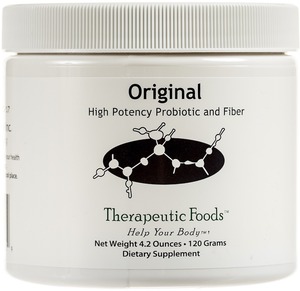Foundational Probiotics
Dear Friends
 |
What makes the BioImmersion probiotics so effective?
The Original Synbiotic Formula offers foundational bacterial organisms with a long history. These species were originally researched by Metchnikoff, have a rich scientific historicity behind them, used as fermenting agents in different societies, and are now packaged in our Original Synbiotic formula.
No wonder we call them pedigreed strains—they have been shown for centuries to bring health building benefits to the human body. The Original Synbiotic provides a powerful symbiotic combination of Lactobacillus acidophilus (ATCC 4356), Streptococcus thermophilus (ATCC 19258), Lactobacillus plantarum (ATCC 8014), Lactobacillus rhamnosus (ATCC 7469) and Bifidobacterium longum (ATCC 15707).
This is a comprehensive everyday formula to be used by the whole family. It combines the five pedigreed human strains of lactic acid bacteria along with the prebiotic soluble fiber inulin, derived from organic chicory root. The formula is dairy free, soy free, kosher, non GMO, and gluten free.*
Food Science
Syngai et al. (2016), Probiotic- the versatile functional food ingredient, summarize the potential health benefits derived from probiotics along with the versatility of their applications for human health as well as animal well-being.
Ilie Metchnikoff (Zoologist and Nobel Laureate who identified, named and researched probiotic bacteria) believed that consumption of the fermenting Lactobacillus positively influenced the microflora of the gut, decreasing the toxic microbial activity of the pathogenic bacterial population (Figueroa-Gonzalez et al. 2011; Sharma et al. 2012).
Syngai et al. (2016) identiy the multiple modes of action by which probiotics can influence our health— (1) Enhancement of epithelial barrier function; (2) Increasing adhesion to intestinal epithelial cells; (3) Competitive exclusion of pathogenic microorganisms; (4) Production of antiomicrobial peptides; (5) Modulation of the immune system. And more.
Intestinal barrier function is maintained by several interrelated systems including mucus secretion, chloride and water secretion, and binding together of epithelial cells at their apical junctions by tight junction proteins (Ng et al., 2009). Streptococcus thermophilus and Lactobacillus acidophilus have been found to limit chloride and water secretion which reversed the E. coli– induced chloride secretion by epithelial cells (Brown, 2011). L. acidophilus and S. thermophilus individually or collectively maintain or stablilize other cytoskeleton structures like actin, AO-1, and occludin when disrupted by pathogenic bacteria (Ng et al. 2009).
Integral to the gut barrier defense is mucus, composed of mucins (MUC 2 and MUC 3), which are secreted from the goblet cells. Mucin polymerization provides the structural foundation of the mucus, granting protection from pathogens, enzymes, toxins, dehydration and abrasion. Lactobacillus plantarum and Lactobacillus rhamnosus have been shown to up-regulate production of intestinal mucins (MUC 2 and MUC 3), which subvert the adherence of the enteropathogenic bacterium Escherichia coli to intestinal epithelial cells, consequently preventing pathogenic bacterial translocation (Hardy et al. 2013).
References:
Brown, M. (2011). Modes of action of probiotics: recent developments. Journal of animal and Veterinary Advances, 10(14), 1895-1900.
Figueroa‐González, I., Quijano, G., Ramírez, G., & Cruz‐Guerrero, A. (2011). Probiotics and prebiotics—perspectives and challenges. Journal of the Science of Food and Agriculture, 91(8), 1341-1348.
Hardy, H., Harris, J., Lyon, E., Beal, J., & Foey, A. D. (2013). Probiotics, prebiotics and immunomodulation of gut mucosal defences: homeostasis and immunopathology. Nutrients, 5(6), 1869-1912.
Metchnikoff, I.I. (1907). The Prolongation of Life: Optimistic Studies. Springer Publishing Company.
Ng, S. C., Hart, A. L., Kamm, M. A., Stagg, A. J., & Knight, S. C. (2009). Mechanisms of action of probiotics: recent advances. Inflammatory bowel diseases, 15(2), 300-310.
Sharma SK, Joshi VK, Sharma S. Probiotics: concepts and applications in food. In: Joshi VK, Singh RS, editors. Food biotechnology: principles and practices. India: IK International Publishing House Pvt
Syngai, G. G., Gopi, R., Bharali, R., Dey, S., Lakshmanan, G. A., & Ahmed, G. (2016). Probiotics-the versatile functional food ingredients. Journal of food science and technology, 53(2), 921-933. doi: 10.1007/s13197-015-2011-0
Sincerely yours,
Seann
We have developed our products based on scientific research and/or the practical experience of many healthcare practitioners. There is a growing body of literature on food based nutrition and supplements and their application in support of our health. Please use our products under the advisement of your doctor.Green Facts:
 At Slow Food Nation’s July 2017 Conference Alice Waters presented her vision for School Lunch as an Academic Subject— click here to see and hear her most illuminating talk— a program that if implemented would transform our US food system into one that heals as apposed to what we are now all experiencing. At Slow Food Nation’s July 2017 Conference Alice Waters presented her vision for School Lunch as an Academic Subject— click here to see and hear her most illuminating talk— a program that if implemented would transform our US food system into one that heals as apposed to what we are now all experiencing.
|
|
©2005 – 2017 BioImmersion Inc. All Rights Reserved
|